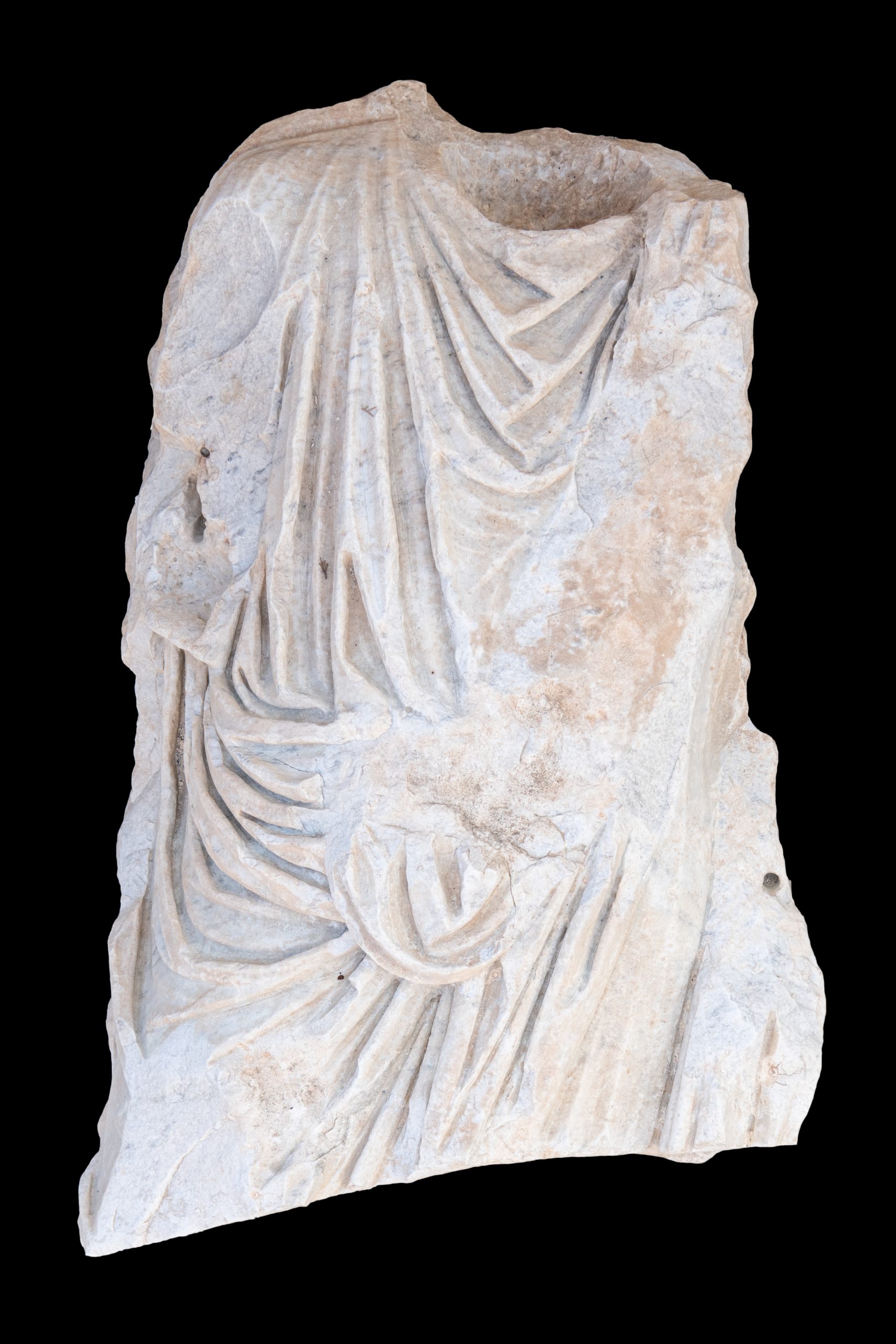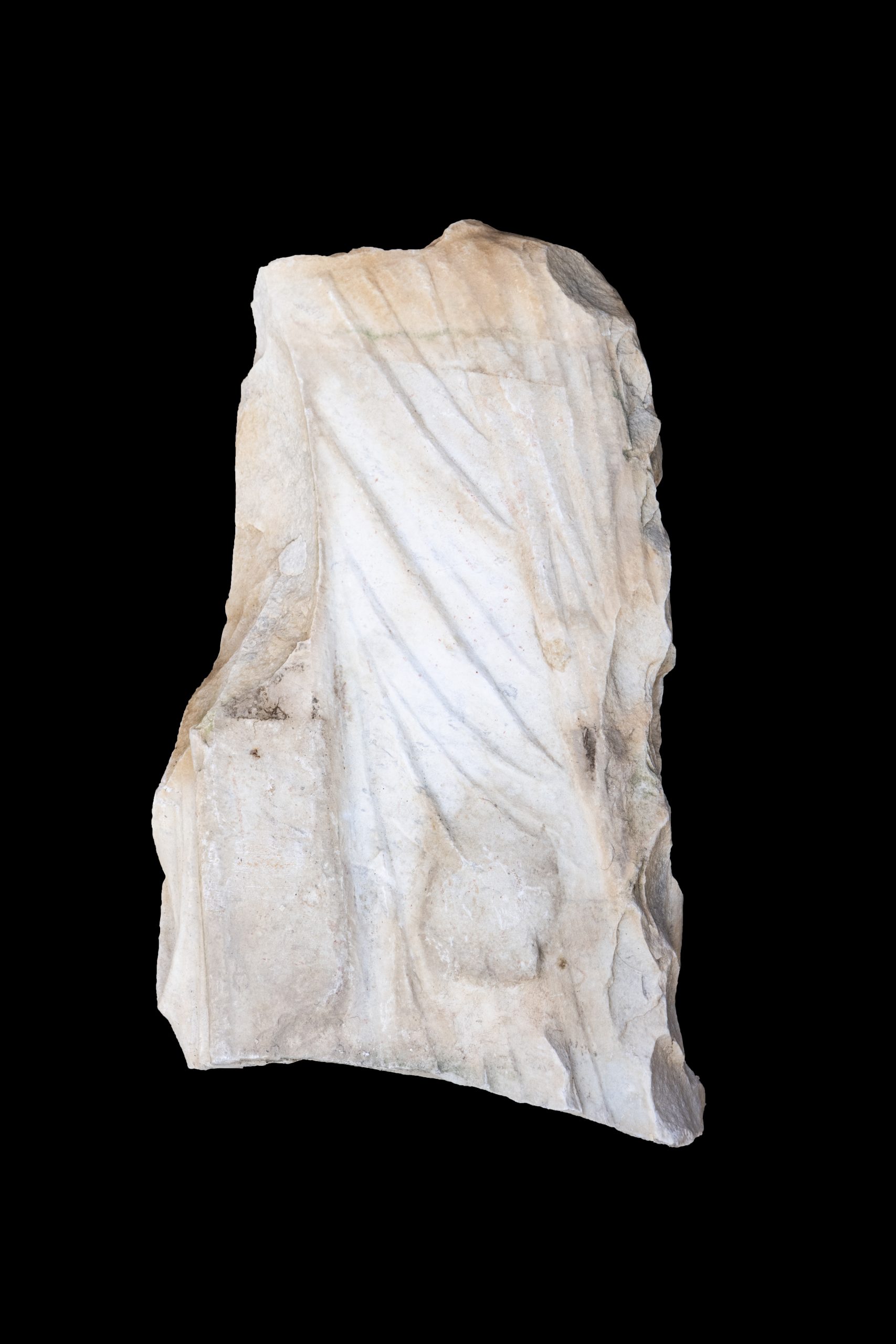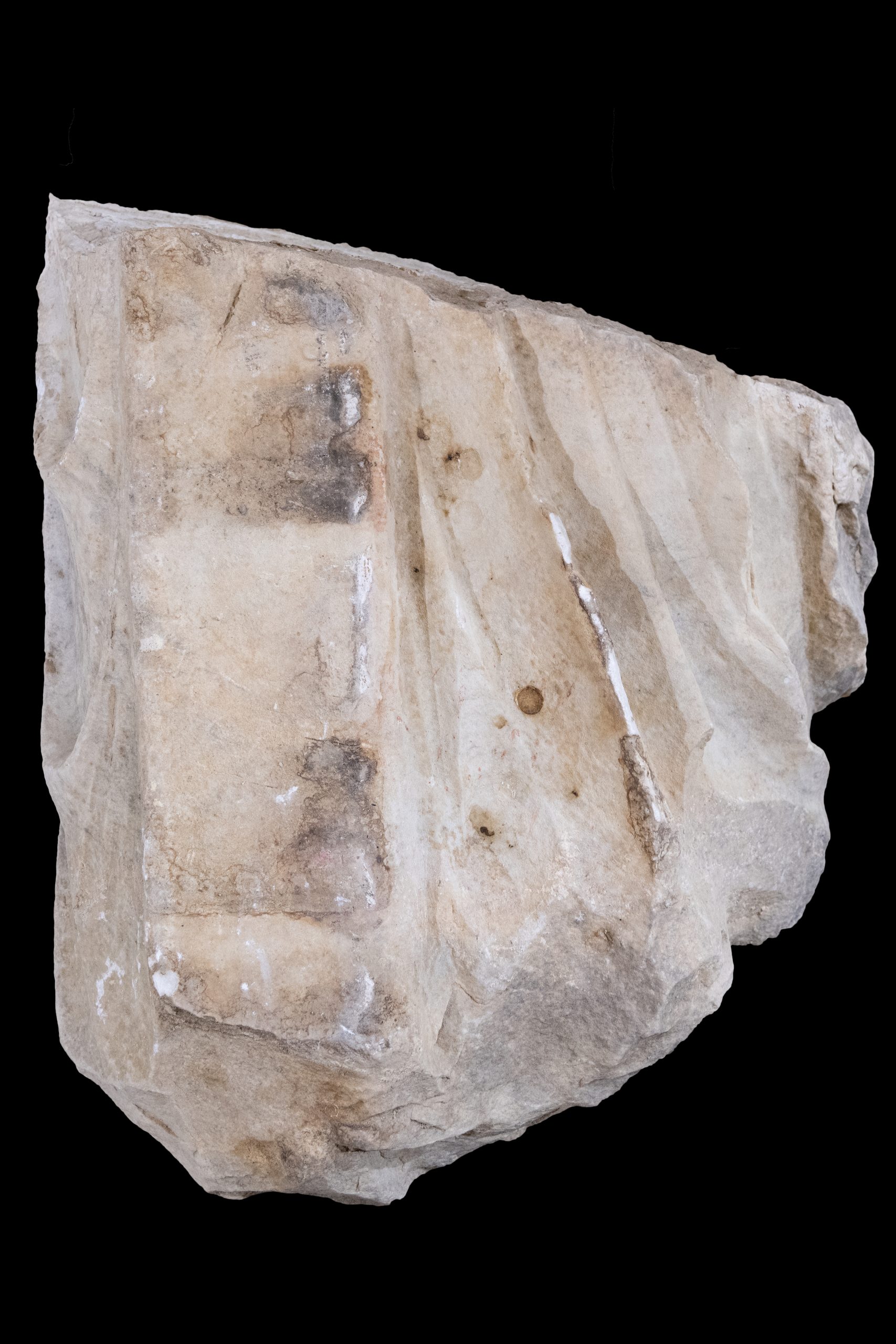I.D. no: 102008
Dimensions: Max. H. (combined) 133 cm;[1] Max. W. 56 cm (in both fragments).
Material: Fine-grain greyish white marble with plenty of dark grey streaks almost all pointing in same direction, from lower left to upper right .
Provenance: Mdina, near the Benedictine Monastery.[2]
Current location: Reserve collection, National Museum of Archaeology.
Condition: The torso is made up of two large fragments of a togate statue broken approximately at the level of the thighs. The two parts were re-joined before 1915 when a photograph of the statue was first published and remained so for a century.[3] Missing are the head (originally inserted separately in the deep hollow between the shoulders); more than half of the right arm; the left arm, affected by a huge break extending from the top of the left shoulder to the left hip, including a large portion of the chest and associated drapery; the lower legs from below the right knee. Two dowel holes: a large one for joining the right forearm and one on the left hip; no dowels on the lower fragment. The dowel hole for the right forearm houses three small cylindrical holes for insertion of metallic dowels. The torso has been severely battered and subjected to many other smaller, but not insignificant, breakages, in particular on the right thigh. The back is treated somewhat more superficially, but not entirely: thick and large drapery folds with high and sharp crests cover the area to the right of an unusual plain, projecting and pillar-like vertical strip with rounded edges which reaches down to the lower break, while the folds to its left are flatter and more curvilinear. The upper fragment presents another unusual anatomical detail at the back, a slightly swollen hump which corresponds to the position of the right buttock. The surface of the drapery is heavily eroded all over, suggesting an exposure to weathering for much longer than the Domus Romana statuary. Most of the surface is covered by a yellowish patina which, however, has flaked off in various parts, revealing the surface of the marble underneath.
Description: The torso belonged to a male figure clad in toga. The figure stood supported on its left leg with the right one flexed at the knee in the act of stepping forward. The drapery of the toga adheres to the body at various points, like the right knee and the left thigh, while it is gathered in thick, and less thick, rolls of folds in other parts, such as the right chest, the horizontal balteus at the waist, forming a u-shaped umbo, and the folds falling in an ample curve from the left forearm to below the right knee and back up the right side to rise to the left shoulder from the back.
Discussion: We are here dealing with a broad and majestic drapery design whose surfaces are still not excessively agitated, datable to the Julio-Claudian period. A certain linear treatment typical of togate statues of the Tiberian reign still prevails but it limits itself to the surface in a pre-eminently decorative function.
Apart from the missing head, which in this replica seems to have been unveiled, the statue follows an iconographic type that belongs to the class of togates with veiled heads, in that it displays the same type of balteus, umbo and sinus of the toga and the same (left) supporting leg. The prototype of these, both from the stylistic and iconographic points of view, is the statue of Augustus as Pontifex Maximus from the Via Labicana.[4] Other comparisons can be made with a statue from Tindari,[5] with another one from the Basilica of Velleia,[6] both dated to the late Julio-Claudian age, and even more strikingly, with the statue in Copenhagen, which F. Poulsen was inclined to assign to the reign of Tiberius.[7]
The toga presents the same pattern and treatment of the folds as that of a portrait statue of Caligula recut into one of Claudius, from Velleia.[8] It falls quite comfortably within H.R. Goette’s classification B (Die Kaiserliche Toga mit u-förmigen Umbo) and sub-group Ba (Die Toga mit u-förmigen Umbo bis zum Ausgang des 1. Jahrhunderts n. Chr.[9] Goette further assigns this statue, together with the one from the Roman Domus of Rabat (ID no. 28973), to the Claudian period, around the mid-first century AD, among a group that includes the Ara Pietatis relief that portrays Claudius himself, at the Villa Medici in Rome.[10]
In view of the dating assigned to the Julio-Claudian age, a further line of investigation would be to determine the possibility, or otherwise, that the head of Claudius acquired in Malta by Jean Houël,[11] now preserved in the Louvre Museum,[12] would fit in size and shape inside the neck of this torso.
Bibliography: (previous publications of item): Ashby 1915: 31, fig. 2: near the Benedictine monastery, draped male torso four feet high. Reinach 1924 (vol. 4): 362, no. 1 (line drawing from Ashby). Zammit 1930: 15 with plate: found in 18th century not far from the site mentioned [i.e. Benedictine convent, Mdina]; good workmanship. Bonanno 1972: 168-171. Goette 1991: 124, no 213: refers correctly to Ashby’s citation but incorrectly connects it with the cycle of Claudian portraits from the Roman Domus of Rabat (his no 214).
[1] As measured by the present writer in 1972 when the two halves were still glued together. During the refurbishing exercise of the Domus Romana Museum in the first decade of the present century, the two halves were dislodged and are currently stored separately. The oblique break accounts for the longer combined maximum height (146 cm) of the two fragments (90 cm upper torso; 66 cm lower torso).
[2] Ashby (1915: 3) specifies only the whereabouts of the find, and in the caption for fig. 2 he erroneously assigns the find to ‘Rabato’ which is really the suburb of Mdina. Zammit (1930: 15) adds the date of the find as ‘18th century’. G.A. Ciantar (1772: 136) refers to a ‘bellissimo busto di marmo d’eccellente scoltura, trovato nello stesso anno 1723 sotto d’una casa del Borgo d’essa città’ which was donated to Grandmaster Manoel de Vilhena; but it is not certain whether he was referring to this torso. Caruana (1882: 116) clearly refers to the same; so Zammit seems to have erroneously conflated his sources.
[3] Now (November 2021) the two fragments are again separated for conservation purposes, awaiting eventual re-joining. The position of a (modern) large circular dowel hole at the centre of the upper break surface of the lower fragment corresponds to that of a more irregularly shaped hole on the lower break surface of the upper fragment. Traces of the gluey substance used for joining the two fragments survive on the corresponding surfaces.
[4] Felletti Maj 1953: 60-61, no 97; Niemeyer 1968: 82, no. 4, pl. 2,1.
[5] Bonacasa 1964: no 185, pl. 81,2.
[6] Saletti 1968: 40-41, no. 6, pls 19-20.
[7] Poulsen 1951: no. 536, pl. 41.
[8] Rose 1997: 122, no 50, pls 132, 135-36.
[9] Goette 1990: 29-42, 113-129.
[10] Goette 1990: 120-24, nos 144-244.
[11] Houël 1787: 108, pl. 261, fig. 1: head marked as f.
[12] De Kersauson 1986:188-189, n° 88.




